 ?Mathematical formulae have been encoded as MathML and are displayed in this HTML version using MathJax in order to improve their display. Uncheck the box to turn MathJax off. This feature requires Javascript. Click on a formula to zoom.
?Mathematical formulae have been encoded as MathML and are displayed in this HTML version using MathJax in order to improve their display. Uncheck the box to turn MathJax off. This feature requires Javascript. Click on a formula to zoom.Abstract
We present a modification of the alternating iterative method, which was introduced by Kozlov and Maz’ya, for solving the Cauchy problem for the Helmholtz equation in a Lipschitz domain. The reason for this modification is that the standard alternating iterative algorithm does not always converge for the Cauchy problem for the Helmholtz equation. The method is then implemented numerically using the finite difference method.
Introduction
The Helmholtz equation
Let be a bounded domain in
with a Lipschitz boundary
. Let
be divided into two disjoint parts
and
such that
is Lipschitz, see Figure . We denote by
the outward unit normal to the boundary
and consider the following Cauchy problem for the Helmholtz equation:
(1)
(1) where the wave number
is a positive real constant,
denotes the outward normal derivative and f and g are specified Cauchy data on
. We are considering real-valued solutions to problem (Equation1
(1)
(1) ).
The Helmholtz equation arises in applications related to acoustic and electromagnetic waves. In the case of acoustic waves, u describes the pressure and the wave number is given by , where
is the frequency and
is the speed of sound. For electromagnetic waves, the wave number k is given in terms of the electric permeability
and magnetic permeability
by
; see [Citation2, Citation3]. The Cauchy problem (Equation1
(1)
(1) ) has physical applications in optoelectronics [Citation4] and characterization of sound sources.[Citation5, Citation6]
The Cauchy problem is an ill-posed problem: its solution is unique but does not depend continuously on the Cauchy data; see [Citation7–Citation10]. A number of methods have been developed for solving the Cauchy problem for the Helmholtz equation such as the potential function method by Sun et al. [Citation11], the modified Tikhonov regularization and the truncation method by Qin et al. [Citation12, Citation13], the modified regularization method based on the solution given by the method of separation of variables by Wei and Qin [Citation14], the method of approximate solutions by Regińska and Regiński [Citation15] and the alternating boundary element method by Marin et al. [Citation16]. For the latter, Marin et al. [Citation16] implemented the alternating iterative algorithm formulated in [Citation17] for a purely imaginary number k and in that case, they solved the Cauchy problem for the modified Helmholtz equation, i.e.They also noticed that the alternating algorithm does not always converge. In this paper, we propose a modification of the alternating algorithm that we used to solve the problem (Equation1
(1)
(1) ). We also analyse the convergence of the modified method and present the numerical results.
Fig. 1 The bounded domain with the boundary
divided into
and
is represented in the left. On the right and on the bottom, the choice of the artificial interior boundaries
,
described in Section 1.4 are presented.

The alternating algorithm
The alternating algorithm was proposed by Kozlov and Maz’ya in [Citation1] for solving ill-posed boundary value problems. Such algorithms preserve the differential equations and every step involves the solution of two well-posed problems for the original differential equation. The regularizing character of the algorithm is ensured solely by an appropriate choice of boundary conditions in each iteration. The method has been used for solving ill-posed problems originating from various applications; see [Citation17–Citation25].
In the alternating iterative algorithm for problem (Equation1(1)
(1) ), one considers the following two auxiliary problems:
(2)
(2) and
(3)
(3) where f and g are given in (Equation1
(1)
(1) ) and the functions
and
are changed in each iteration of the algorithm. The standard alternating iterative procedure for solving the problem (Equation1
(1)
(1) ) is as follows:
The first approximation
is obtained by solving (Equation2
(2)
(2) ), where
is an arbitrary initial approximation of the normal derivative on
.
Having constructed
, we find
by solving (Equation3
(3)
(3) ) with
on
.
We then find
by solving (Equation2
(2)
(2) ) with
on
.
Non-convergence of the standard algorithm
In this section, we show by an example that the original alternating iterative algorithm does not converge for large values of the constant in the Helmholtz equation. For this purpose, we consider the following Cauchy problem in the rectangle
:
(4)
(4) where
. This problem is ill–posed.
Denoting and
, we observe for this problem that the Cauchy data
and
described in problem (Equation1
(1)
(1) ) are set to zero. Choosing an initial approximation of the normal derivative
, we use the algorithm described in Section 1.2 and find that
where
and
. Also,
and
are given by
and
respectively. Notice that the solution to (Equation4
(4)
(4) ) is
. Let us define
Using Parseval’s identity, we obtain that
The sequence
converges to 0 in
when
, where
The sequence
diverges for
We, thus, conclude that the algorithm does not always converge for the Cauchy problem for the Helmholtz equation.
A modified alternating algorithm
To formulate the modified alternating algorithm for the geometries described in Figure on the right and on the bottom, we first introduce an interior boundary as follows: let
be open subsets inside the domain
with
for
, such that
for
. We assume that every
is a Lipschitz domain. We denote by
the boundaries of
, respectively, and by
the outward unit normal to the boundary
. Let
with boundary
and
. Then
.
Now let be a function defined in
and put
We denote by
the jump of the function
and the jump of the normal derivative
across
, respectively. To describe the modified algorithm, we also choose a positive constant
so that the bilinear form associated to the Helmholtz equation, the boundary
, and the constant
is positive, i.e.,
(5)
(5) for
such that
. The algorithm consists of solving in an alternating way the following two well–posed boundary value problems:
(6)
(6) and
(7)
(7) The modified alternating iterative algorithm for solving (Equation1
(1)
(1) ) is as follows:
The first approximation
is obtained by solving (Equation6
(6)
(6) ), where
is an arbitrary initial approximation of the normal derivative on
and
is an arbitrary approximation of
on
.
Having constructed
, we find
by solving (Equation7
(7)
(7) ) with
on
and
on
.
We then obtain
by solving the problem (Equation6
(6)
(6) ) with
on
and
on
.
Bilinear form and properties of traces
In this section, we introduce the function spaces, used in this paper. We define the bilinear form associated to the Helmholtz equation, the boundary and the constant
. We also define the normal derivative of functions that satisfy the Helmholtz equation.
Function spaces
We denote by the space of square integrable functions in
. The Sobolev space
consists of all functions in
whose first-order weak derivatives belong to
. The space
is a Hilbert space with the inner product
The corresponding norm is given by
We also define
as the subspace to
of functions in
that vanish on
. Let
be the space of traces of function in
on
. One of the equivalent norms in this space is given by
where
and
denote surface measures. Similarly, we define
as the space of traces of function in
on
. We denote by
the space of restrictions of functions belonging to
to
. The space
is defined similarly. We also denote by
the space of functions from
vanishing on
. The norm in this space is given in Lions and Magenes (see [Citation28, Chapter 1, Section 11.5]) by
where
is the distance from
to
. We will denote the dual space of
by
. This space is equipped with the norm of dual spaces:
The space
is defined in the same way.
A bilinear form 
 and a sufficient condition for
and a sufficient condition for 
 to be positive definite
to be positive definite
Let u be a smooth solution to the Helmholtz equation(8)
(8) Green’s formula and (Equation8
(8)
(8) ) yield that
(9)
(9) for all
. Now assume that
is a positive constant. By adding the expression
to both sides of (Equation9
(9)
(9) ), we obtain that
(10)
(10) for all
.
Let us introduce a bilinear form , defined by
(11)
(11) Since we assume that (Equation5
(5)
(5) ) holds, this form is an inner product on
and the corresponding norm defined by
for every
is an equivalent norm in
; (see [Citation29, Chapter 1, Section 1.2]).
We now prove a sufficient condition for the form to be positive definite on
.
Lemma 2.1
Put(12)
(12) and
(13)
(13) where
. Then there exists a positive constant
such that
(14)
(14)
Proof
It follows directly from (Equation12(12)
(12) ) and (Equation13
(13)
(13) ) that
. The infimum in (Equation12
(12)
(12) ) is attained for a function
. Since
, formula (Equation12
(12)
(12) ) shows that
(15)
(15) On the other hand, since
solves (Equation12
(12)
(12) ),
(16)
(16) for every function
. The identity (Equation16
(16)
(16) ) now implies that
(17)
(17) Now let
be a decomposition of
, where
is harmonic outside
and satisfies
Using a result from [Citation30, Chapter 7], we see that
(18)
(18) Replacing
by
in (Equation17
(17)
(17) ), we obtain the following problem:
(19)
(19) Multiplying the first equation of (Equation19
(19)
(19) ) by
, integrating by parts and taking into account the boundary conditions, we obtain that
The Cauchy–Schwarz inequality now shows that
(20)
(20) We observe from (Equation19
(19)
(19) ) that the function
belongs to
and
on
. We thus have from (Equation13
(13)
(13) ) that
This relation together with (Equation20
(20)
(20) ) give that
which leads to
(21)
(21) Since
, it follows from (Equation21
(21)
(21) ) that
Using the estimate (Equation18
(18)
(18) ) and the fact that
, we see that
The result now follows from (Equation15
(15)
(15) ).
Theorem 2.2
If is positive, then
for sufficiently large
.
Traces and their properties
In this section, we define the trace spaces and their properties. We begin by giving the definition of a weak solution to the Helmholtz Equation (Equation8(8)
(8) ). Let us define
.
Definition 2.3
A function is called a weak solution to the Helmholtz equation (Equation8
(8)
(8) ) if
(22)
(22) for every function
.
Let denote the space of weak solutions to (Equation8
(8)
(8) ). Assume that
is a classical solution to (Equation8
(8)
(8) ). The identity (Equation9
(9)
(9) ) can be used to define the normal derivative
on
and on
for a solution to (Equation8
(8)
(8) ). It follows from [Citation28, Chapter 1, Section 9.2] that for any pair of functions
and
, there exists a function
such that
on
and
on
, satisfying
(23)
(23) where the constant
is independent of
and
.
Lemma 2.4
There exists a bounded linear operatorsuch that for
and
,
(24)
(24) where
satisfies
and
. Moreover,
Proof
We first show that the right–hand side of (Equation24(24)
(24) ) is independent of the choice of
. Let
. If
and
on
and
on
, then the difference
belongs to
. From (Equation22
(22)
(22) ), we therefore have that
It follows that
Thus, the definition of
does not depend on
. We now show that
is a bounded operator from
to
. Applying the Cauchy–Schwarz inequality to the right–hand side of (Equation24
(24)
(24) ), we get that
Together with (Equation23
(23)
(23) ), this yields that
which shows that
belongs to
and that
is bounded.
The main theorem
We now prove the main theorem in this paper. We denote the sequence of solutions to (Equation1(1)
(1) ), obtained from the modified alternating algorithm described in Section 1.4 by
. The proof uses a similar argument as in [Citation17].
Theorem 3.1
Suppose that assumptions on the choice of the interior boundary formulated in Section 1.4 and the positivity of the quadratic form (Equation5(5)
(5) ) are fulfilled. Let
and
, and let
be the solution to problem (Equation1
(1)
(1) ). Then, for every
and every
, the sequence
, obtained from the modified alternating algorithm, converges to
in
.
Proof
Lemma 2.4 shows that . Since
it follows that
which means that we can assume that
. Then
solves problem (Equation6
(6)
(6) ) with
on
,
on
and
on
. From (Equation10
(10)
(10) ) and (Equation11
(11)
(11) ), we have that
Notice that
solves problem (Equation7
(7)
(7) ) with
on
,
on
and on
. Again, it follows from (Equation10
(10)
(10) ) and (Equation11
(11)
(11) ) that
From these relations, we obtain that
(25)
(25) and
(26)
(26) It thus follows from (Equation25
(25)
(25) ) and (Equation26
(26)
(26) ) that the sequence
is decreasing.
In the following, we denote the space by
. Now for
, put
. We will show that the set
of pairs
such that
converges to zero in
is closed in
. Suppose that
and
. Notice that
Squaring both sides, we obtain that
(27)
(27) Since
is decreasing, we have that
Using the fact that
is a solution to problem (Equation6
(6)
(6) ), we obtain that
Now consider the second term in the right–hand side of (Equation27
(27)
(27) ). Since we have assumed that
,
tends to zero as
. This shows that
converges to zero in
and thus that
.
To show that , it suffices to prove that
is dense in
. Assume that
and
satisfy
(28)
(28) for every
and
. We shall prove that
on
and
on
.
Consider a function that satisfies (Equation7
(7)
(7) ) with
on
,
on
and
on
. The relation (Equation10
(10)
(10) ) and the expression (Equation28
(28)
(28) ) and using the fact that
on
and
on
, we obtain that
Let
be a solution to (Equation7
(7)
(7) ) with
on
and
on
and on
. The above expression thus gives
(29)
(29) Now let
be a function that satisfies (Equation6
(6)
(6) ) with
on
,
on
and
on
. From (Equation29
(29)
(29) ), we obtain that
The relation (Equation10
(10)
(10) ) yields that
Using again the relation (Equation10
(10)
(10) ) and since the function
satisfies (Equation6
(6)
(6) ) with
on
,
on
and
on
, we arrive at
Since
and
are arbitrary functions, we have
on
and
on
. On the other hand, since
on
,
on
, and
on
, we obtain that
on
. Now, using the fact that
solves the Helmholtz equation in
, it follows that
. From the fact that
on
, it follows that
in
. Thus,
on
and
on
. This shows that
is dense in
. Since
is closed and dense in
, we have
. That means that for any
, the sequence
converges to zero in
. Since we assumed that
, the theorem is thus proved.
Remark
The boundary value problem (Equation6
(6)
(6) ) can be replaced by
where
is a positive constant. The alternating iterative algorithm described above thus runs the same way, where, for any even step, the boundary condition
on
is used instead of the boundary condition
on
. This case is considered in the numerical experiments in the next section.
The alternating iterative method described here does not converge if the boundary value problem (Equation7
(7)
(7) ) is given by
In that case, the even steps of the algorithm in Section 1.4 are kept the same and for any odd step, one wants to find
by solving the above problem with
on
and
. The proof of the main theorem thus does not hold since the sequence
is not monotonic. In fact, the Equations (Equation25
(25)
(25) ) and (Equation26
(26)
(26) ) become
and
from which we conclude that the sequence
is neither decreasing nor increasing.
We also have the same convergent result, if we replace the Laplacian operator
by an elliptic operator
, where
is a symmetric matrix whose elements are bounded and measurable real–valued functions and the normal derivative
replaced by the conormal derivative
.
We do not discuss the stopping rule here but one can use the same stopping rule as in [Citation19, Section 7].
Numerical results
In this section, we present some numerical experiments. The results are obtained using the modified alternating algorithm presented in the previous sections, where the well–posed boundary value problems (Equation6(6)
(6) ) and (Equation7
(7)
(7) ) are solved using the finite difference method (FDM). We also verify the non–convergence result for the standard alternating algorithm. We let
, where
, be the domain and consider the following problem:
We put
and
. Our aim is to compare the numerical and exact solutions at
.
For the implementation of the modified algorithm, the interior boundary discussed in Section 1.4 is chosen so that the eigenvalue for the problem inside
and the eigenvalue for the problem outside
are approximately equal so that the relation (Equation14
(14)
(14) ) in Section 2.2 is satisfied. Different choices of
are discussed in Examples 4.1 and 4.2. We first provide details about the FDM. We discretize the domain by choosing an equidistant grid:
with the grid size
. Note that, since we want the grid size to be equal in the
- and
-directions, we use
. In that case,
and the same step size is used in the
- and
-directions. Let
denote the discrete approximation to
. The finite difference approximation for the Helmholtz equation at each interior point
simplifies to
At the boundaries corresponding to
, and
, the value of the function
is zero and the corresponding variables
are explicitly set to zero. However, at the boundaries corresponding to
, and
we get different equations depending on the type of the boundary condition. For the Dirichlet boundary conditions, we get the discretization of the form
where
is the prescribed Dirichlet data at
or
. The discretization of the Neumann boundary conditions is given by
and
is the prescribed Neumann data at
or
. This particular choice means that we approximate the Neumann condition with accuracy
.
According to the type of the boundary data at and
, the discretization of the two well–posed boundary value problems (Equation6
(6)
(6) ) and (Equation7
(7)
(7) ) using the finite difference approximation discussed above leads to two different types of linear systems
,
, where each
is a large sparse matrix of size
, and each
is a vector that contains the boundary data values. These systems are solved in an alternating way using the LU factorization of the matrix
. Since each matrix
depends only on the size of the domain, the parameter
and the parameter
, but not on the actual boundary data values, we can save the matrix
and its sparse LU factorization between iterations. This significantly improves the computational speed.
Fig. 2 Numerical solution obtained by solving the direct problem with boundary conditions
and
is displayed to the left. On the right we plot
(dashed line) and
(solid line) for
.
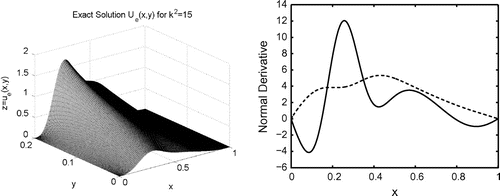
Fig. 3 On the left, we show the value of the exact solution at (solid line) and the reconstructed function (dashed line) for
. The divergence of the algorithm for
is shown on the right where we plot the error
for 1500 iterations.
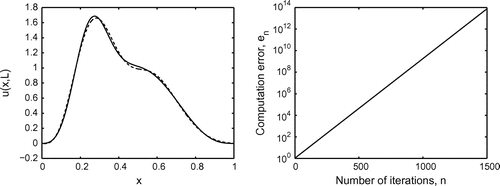
Fig. 4 The solid lines represent the exact solution and the dashed lines the numerical solution
. On the left, we present the results when no noise is added to the data. The corresponding results when a normally distributed random noise of variance
is added to the data are presented on the right.
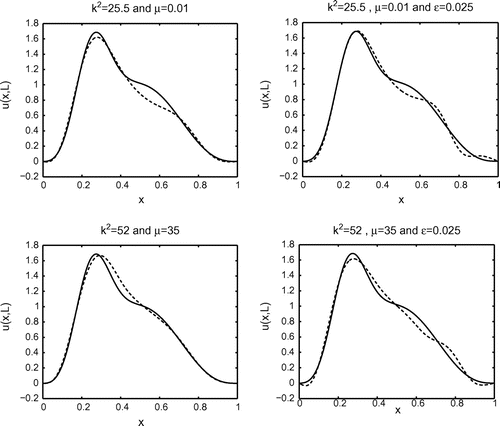
Fig. 5 The boundary condition is replaced by the boundary condition
in the modified alternating algorithm. The solid lines represent the exact solution
and the dashed lines the numerical solution
. On the right a normally distributed random noise of variance
is added to the data.
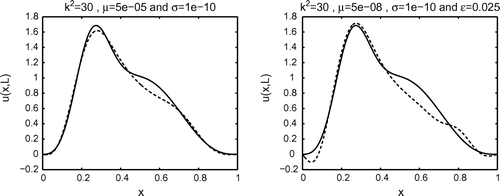
Fig. 6 Two interior boundaries described in Example 4.2 are chosen. The solid lines represent the exact solution and the dashed lines the numerical solution
. On the right a normally distributed random noise of variance
is added to the data.
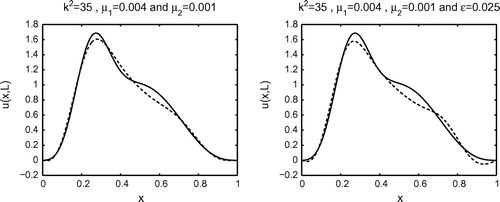
For the numerical computations, we particularly choose ,
and
, and select the boundary data
on
as
The exact boundary data on
, used to test the performance of the algorithm, is given by
The boundary data
is obtained numerically after solving the direct problem for the Helmholtz equation with boundary data
and
given above and
. The numerical solution is displayed in Figure . To start the algorithm, we chose an arbitray initial guess
on
. In order to test the convergence of the algorithm, we compute the following norm
where
is the numerical solution at
and
the iteration number. For all tests, the results are displayed after 1500 iterations. In Figure , we display the convergence of the standard alternating iterative algorithm, described in Section 1.2, for
and its divergence for
. Notice that the algorithm diverges for
according to the results in Section 1.3. This confirms the fact that the standard algorithm does not always converge. We can now implement the modified alternating iterative algorithm. For this, we need to choose the interior boundary
.
Example 4.1
We choose the interior boundary as follows: we first choose the centre of gravity of the rectangle . We pick the interior boundary as a rectangle with the same centre of gravity as
, and side lengths
and
. The interior domain is
with boundary
. For the test, we chose
,
and
. The boundary data values on
are chosen numerically so that they will be different from the values of the exact solution on
.
Figure shows the exact and numerical results for for different values of
and
. We also present the corresponding results when a normally distributed random noise of variance
is added on the data
and
.
For the results in Figure , it can be seen that when the boundary condition is replaced by the boundary condition
with the initial guess given by
, the algorithm converges. In this case, we have observed the improvement of the numerical results for the values of
and
relatively small.
Example 4.2
We now choose two interior boundaries and
. The first rectangle is
with boundary
and the second rectangle
inside
has boundary
. For the test, we chose
,
,
and
. As above, the boundary data values on
and
are chosen numerically. The numerical results are shown in Figure and it can be observed that accurate and stable results are obtained.
Acknowledgments
The work of Lydie Mpinganzima is supported by the Swedish Development International Agency (SIDA) and the National University of Rwanda (NUR).
References
- Kozlov VA, Maz’ya VG.On iterative procedures for solving ill-posed boundary value problems that preserve differential equations, Algebra i Analiz. 1989;192: 1207–1228 (in Russian)
- Colton D, Kress R. Inverse acoustic and electromagnetic scattering theory 2nd ed. Berlin: Springer; 1998
- JonesDS. Acoustic and electromagnetic waves. Oxford: Clarendon Press; 1986
- Regińska T, Regiński K. Approximate solution of a Cauchy problem for the Helmholtz equation. Inverse Problems. 2006;22:975–989.
- Langrenne C,Garcia A. Data completion method for the characterization of sound sources. J. Acoust. Soc. Am. 2011; 130:2016–2023.
- Schuhmacher A, Hald J, Rasmussen KB, Hansen PC. Sound source reconstruction using inverse boundary element calculations. J. Acoust. Soc. Am. 2003;113:114–127.
- Arendt W, Regińska T. An ill-posed boundary value problem for the Helmholtz equation on Lipschitz domains. J. Inv. Ill-Posed Problems. 2009;17:703–711.
- Hadamard J. Lectures on Cauchy’s problem in linear partial differential equations. New York (NY): Dover Publications; 1952.
- John F. Continuous dependence on data for solutions of partial differential equations with a prescribed bound. Commun. Pure Appl. Math. 1960;13:551–585.
- Lavrent’ev MM,Romanov VG, Shishatskii SP. Ill-posed problems of mathematical physics and analysis. Providence (RI): American Mathematical Society; 1986.
- Sun Y, Zhan D, Ma F. A potential function method for the Cauchy problem for elliptic equation. J. Math. Anal. Appl. 2012;395:164–174.
- Qin HH, Wei T. Modified regularization method for the Cauchy problem of the Helmholtz equation. Appl. Math. Model. 2009;33:2334–2348.
- Qin HH, Wei T, Shi R. Modified Tikhonov regularization method for the Cauchy problems of the Helmholtz equation. J. Comput. Appl. Math. 2009;24:39–53.
- Qin HH, Wei T. Two regularization methods for the Cauchy problems of the Helmholtz equation. Appl. Math. Model. 2010;34:947–967.
- Regińska T, Wakulicz A. Wavelet moment method for the Cauchy problem for the Helmholtz equation. J. Comput. Appl. Math. 2009;223:218–229.
- Marin L, Elliott L, Heggs PJ, Ingham DB, Lesnic D, Wen X. An alternating iterative algorithm for the Cauchy problem associated to the Helmholtz equation. Comput. Meth. Appl. Mech. Eng. 2003;192:709–722.
- Kozlov VA, Maz’ya VG, Fomin AV. An iterative method for solving the Cauchy problem for elliptic equations. Comput. Maths. Math. Phys. 1991;31:46–52.
- Avdonin S, Kozlov V, Maxwell D, Truffer M. Iterative methods for solving a nonlinear boundary inverse problem in glaciology. J. Inv. Ill-Posed Problems. 2009;17:239–258.
- Bastay G, Johansson T, Kozlov VA, Lesnic D. An alternating method for the stationary Stokes system. Z. Angew. Math. Mech. 2006;86:268–280.
- Comino L, Marin L, Gallego R. An alternating iterative algorithm for the Cauchy problem in anisotropic elasticity. Eng. Anal. Boundary Elements. 2007;31:667–682.
- Chapko R, Johansson BT. An alternating potential-based approach to the Cauchy problem for the Laplace equation in a planar domain with a cut. Comput. Meth. Appli.Math. 2008;8:315–335.
- Lesnic D, Elliot L, Ingham DB. An alternating boundary element method for solving numerically the Cauchy problems for the Laplace equation. Eng. Anal. Boundary Elements. 1997;20:123–133.
- Lesnic D, Elliot L, Ingham DB. An alternating boundary element method for solving Cauchy problems for the biharmonic equation. Inverse Probl. Eng. 1997;5:145–168.
- Marin L, Elliott L, Ingham DB, Lesnic D. Boundary element method for the Cauchy problem in linear elasticity. Eng. Anal. Boundary Elements. 2001;25:783–793.
- Maxwell D, Truffer M, Avdonin S, Stuefer M. An iterative scheme for determining glacier velocities and stresses. J. Glaciol. 2008;54:888–898.
- Johansson BT, Kozlov VA. An alternating method for Helmholtz-type operators in non-homogeneous medium. IMA J. Appl. Math. 2009;74:62–73.
- Mpinganzima L. An alternating iterative procedure for the Cauchy problem for the Helmholtz equation. Thesis No. 1530, Linköping; 2012.
- Lions JL, Magenes E. Non-homogeneous boundary value problems and applications. Berlin: Springer; 1972.
- Nečas J. Les Méthodes Directes en Théorie des Equations Elliptiques [Direct methods in the theory of elliptic equations]. Paris: Masson; 1967.
- Dahlberg BEJ, Kenig CE. Harmonic analysis and partial differential equations. Technological report. Göteborg: Chalmers University of Technology; 1985 Available from: http://www.math.chalmers.se/Math/Research/GeometryAnalysis/Lecturenotes/HAPE.ps [2009-01-07]
